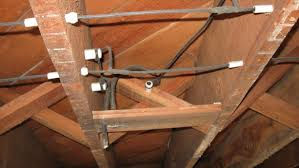Knob-and-tube Wiring Explained
- Mejaro Inspection Services

- Jul 8, 2020
- 2 min read
Updated: Aug 27, 2020

What is knob-and-tube wiring?
Knob-and-tube wiring (K&T) is an old system of electrical wiring predominantly found in older homes and buildings that were built in the late 1800's or early 1900's. It gets its name from -- you guessed it! -- its characteristic white knobs and black tubes that encase the home's electrical wires. K&T essentially consists of insulated tubes that house the home's copper electrical wires. These tubes are intermittently supported by porcelain knobs that are secured with nails.

K&T has some inherent safety concerns and is thus obsolete and not permitted in any new construction today. Different areas of the country have their own rules and regulations as to whether or not existing K&T must be removed. At the very least, it is a good idea to have your home's wiring inspected by a local home inspector or electrician in order to ensure that there are no imminent safety issues.
Pros of knob-and-tube wiring
One of the greatest advantages of K&T is that its porcelain knobs and tubes and very durable and often last forever! Additionally, these porcelain components are not flush against the framing and so are not conducive to damage by nails, screws, etc. Another great feature of K&T is that it can carry wires of higher amps than today's wiring systems because there is a greater distance between hot and neutral wires, allowing for heat to more easily dissipate. Finally, K&T wiring was difficult to install and required the work of highly skilled professionals. As a result, it was most often done very well and contained few installation errors.
On the flip side, K&T is sometimes dangerous. Not only are the insulation materials a potential fire hazard; they also tend to sag and deteriorate over time. Perhaps the greatest issue with K&T is that it doesn't contain a grounding conductor and therefore cannot support any 3-pronged appliances. In general, this increases the chance of an electrical fire. Because it works by dissipating heat into the surrounding air, K&T becomes even more of a fire hazard when it is near or encased in insulation.
Tips for homeowners
If you live in an older home that contains K&T wiring, you'll want to keep your eye out for potential problems and enlist the help of a professional to ensure that your home's electrical wiring is safe and efficient.
Be cognizant of your home's total electrical load. In other words, make sure that your wiring system can support all of your electrical appliances so as to avoid a potential fire hazard.
Ensure that all wires are a safe distance away from any surrounding insulation.
Replace any brittle or cracked wiring.
Because K&T wiring is not grounded, it should NOT be used in your kitchen, laundry room, or outside areas.
Make sure that any modifications made to your K&T wiring system over the years were done correctly and with safety in mind.
Above all else, please remember that safety comes first. Electricity (and wiring) is no laughing matter and requires the help of highly skilled professionals!
#C&MElectricalEnterpriseInc







Comments